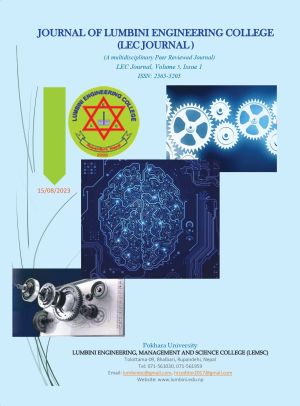Influence of Egg Shell Powder, Bagasse Ash and Lime on Stability of Soil
DOI:
https://doi.org/10.3126/lecj.v5i1.60127Keywords:
Sugarcane Bagasse Ash, Egg Shell Powder, Direct shear strength, California Bearing Ratio, Swelling IndexAbstract
Foundation is indispensable part of any civil construction. Construction of building structures and other civil engineering structures such as roadways, railways, waterways, airports, water retaining structures, involve huge human and financial resources and their construction on loose or weak soil is a threat to both humans and the project itself, and can also result into loss of both. Construction on weak soil has been significant challenge for geotechnical engineers since time immemorial, thus various types of soil stabilizers are used to stabilize weak soil whose selection depends upon the availability of the stabilizing material, soil properties, environmental condition, foundation type and the budget of the project. The present study intends to evaluate the influence of mixture of sugarcane bagasse ash (SABS), egg shell powder (ESP) and lime on weak soil so as to stabilize it. The physical properties of original soil sample and aforementioned additives mixed soil sample have been carefully determined by conducting sieve analysis, Atterberg’s limit test, direct shear strength, Modified Proctor test, California Bearing Ratio (CBR), specific gravity test and free swell index test. Comparative analysis was carried out among all the samples to determine the optimum percentage of sugarcane bagasse ash, egg shell powder and lime required for the stabilization of the weak soil under study. The use of bagasse ash, eggshell powder and lime showed favorable results when determining the geotechnical properties of various sample mix. Despite decrease in the cohesion and maximum dry density during addition of bagasse only in the sample mix, addition of other additives even in small amount brought positive impact in the results. The value of angle of internal friction increased from 23.24 degrees to 29.08 degrees and cohesion increased from 0.19 kg/cm2 to 0.21 kg/cm2. Similarly maximum dry density also increased form 16.54 kN/m3 to 17.42 kN/m3 and optimum moisture content decreased from 16.26% to 15.76%.
Downloads
Downloads
Published
How to Cite
Issue
Section
License

This work is licensed under a Creative Commons Attribution-NonCommercial 4.0 International License.
This license allows reusers to distribute, remix, adapt, and build upon the material in any medium or format for non-commercial purposes only, and only so long as attribution is given to the creator.




